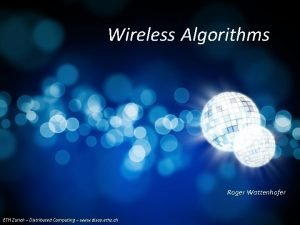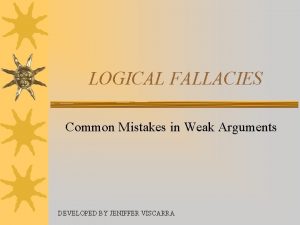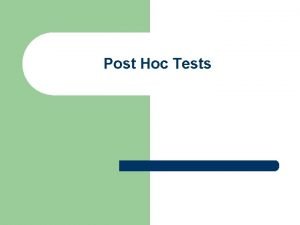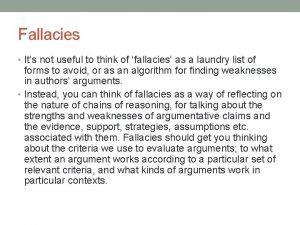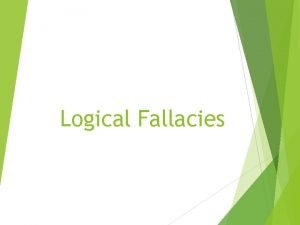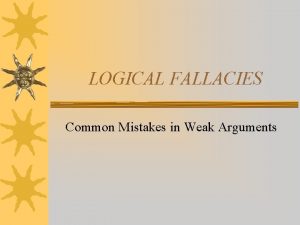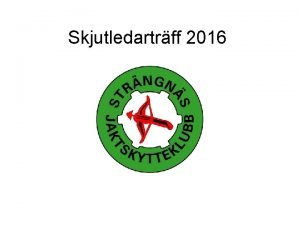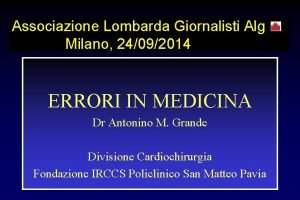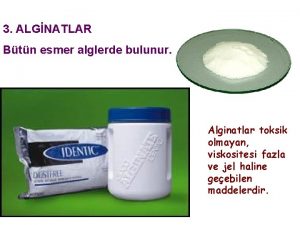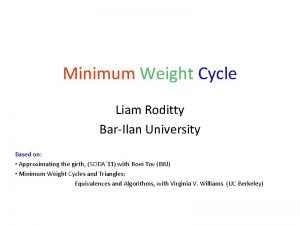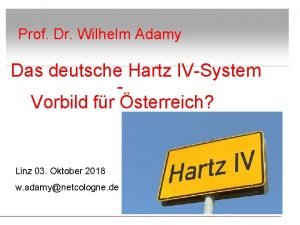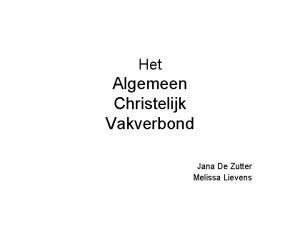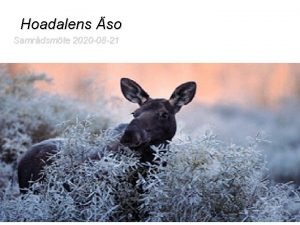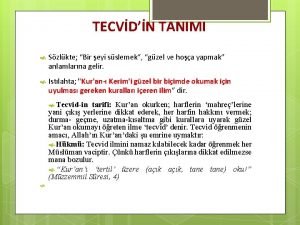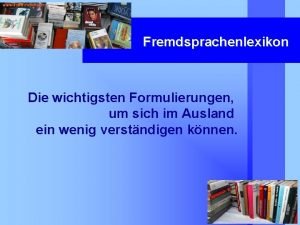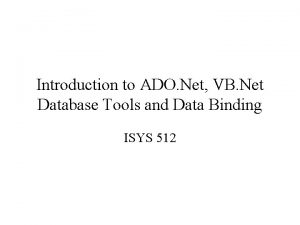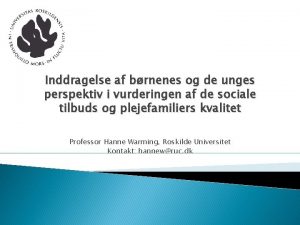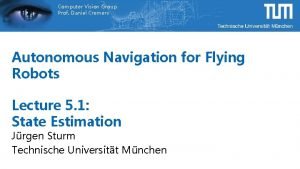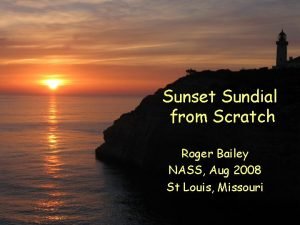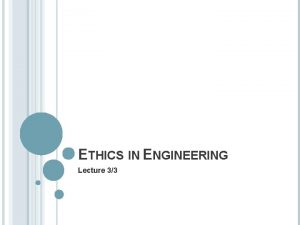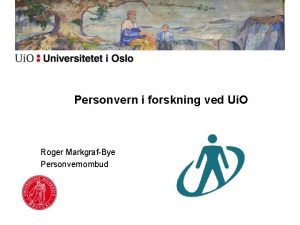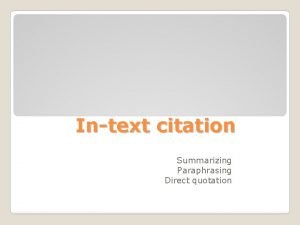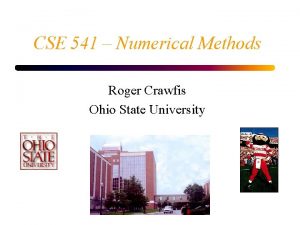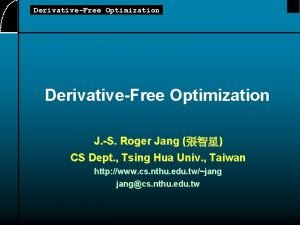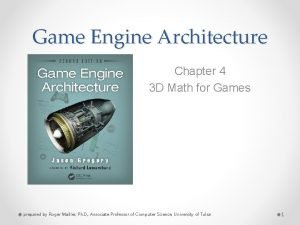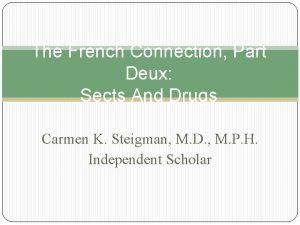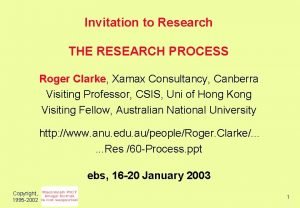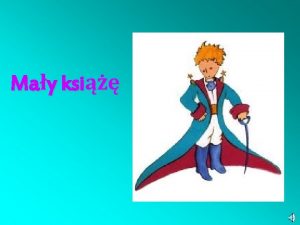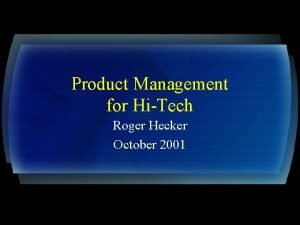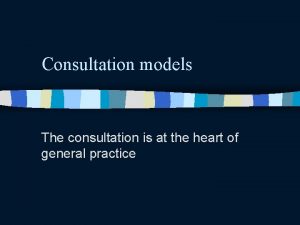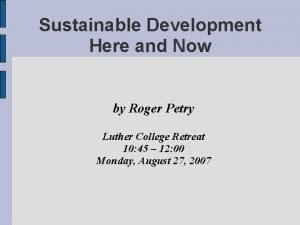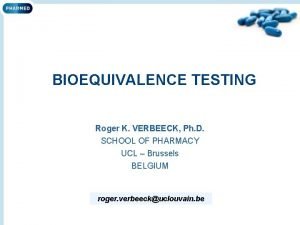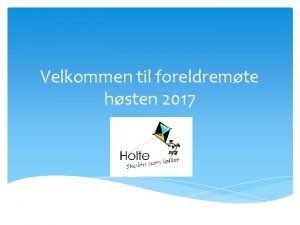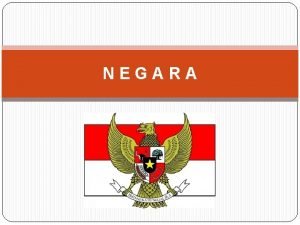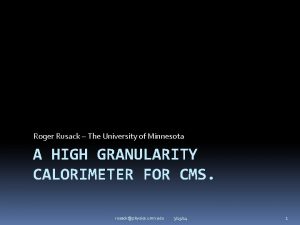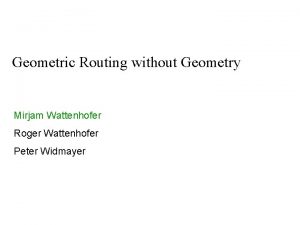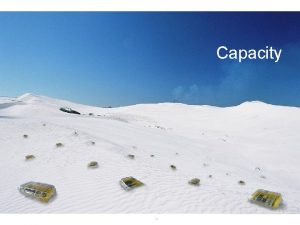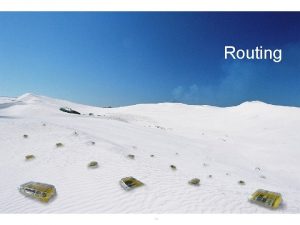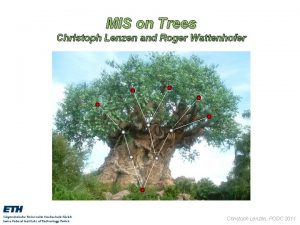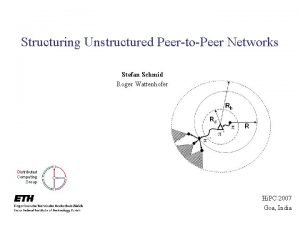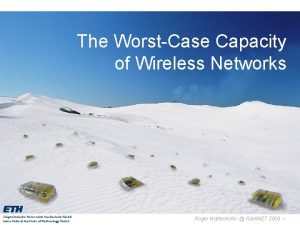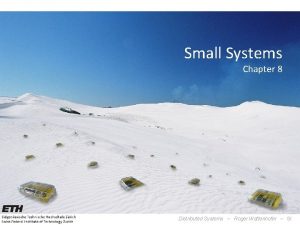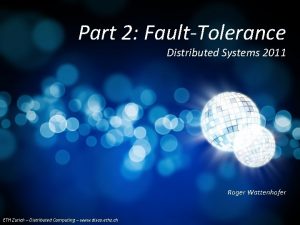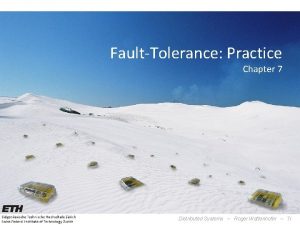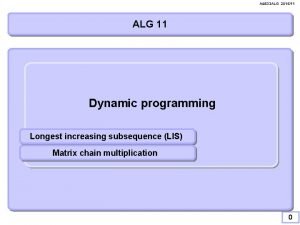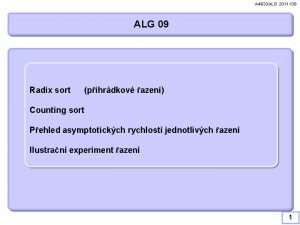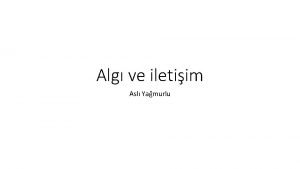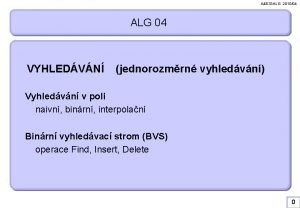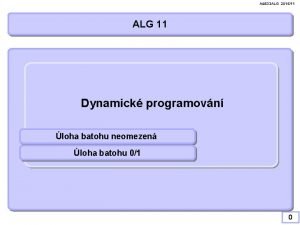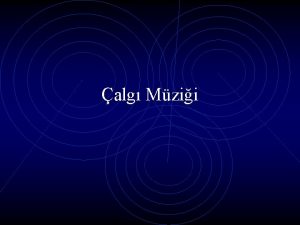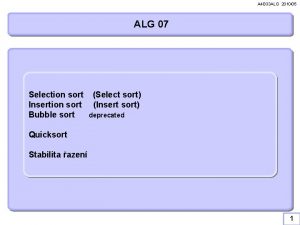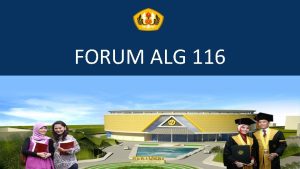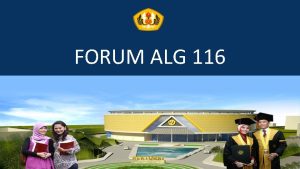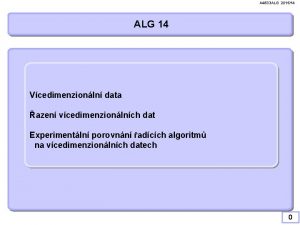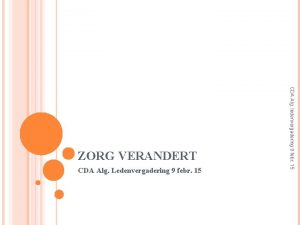alg hoc 2005 net Roger Wattenhofer Med Hoc


















































- Slides: 50

alg hoc 2005 net Roger Wattenhofer Med. Hoc. Net 2005 Algorithms for Ad Hoc Networks

Distributed Algorithms vs. Ad Hoc Networking • Small community • Big community • O(…), (…) • Milliseconds • Everybody knows best paper • Everybody knows first* paper • New algorithm: Compare it with the best previous • New protocol: Compare it with the first that was proposed • Sometimes study the wrong problem; propose protocols that are way too complicated • Reinvent the wheel; many papers do not offer any progress Roger Wattenhofer, ETH Zurich @ Med. Hoc. Net 2005 2

Algorithmic Research in Ad Hoc and Sensor Networking • • • • Clustering (Dominating Sets, etc. ) MAC Layer and Coloring Topology and Power Control Interference and Signal-to-Noise-Ratio Deployment (Unstructured Radio Networks) New Routing Paradigms (e. g. Link Reversal) Geo-Routing Broadcast and Multicast Data Gathering Location Services and Positioning Time Synchronization Modeling and Mobility Lower Bounds for Message Passing Selfish Agents, Economic Aspects, Security Roger Wattenhofer, ETH Zurich @ Med. Hoc. Net 2005 Link Layer Network Layer Services Theory/Models 3

Overview • Introduction – Ad Hoc and Sensor Networks – Routing / Broadcasting • Clustering • Conclusions Roger Wattenhofer, ETH Zurich @ Med. Hoc. Net 2005 4

Routing in Ad Hoc Networks • Multi-Hop Routing – Moving information through a network from a source to a destination if source and destination are not within mutual transmission range • Reliability – Nodes in an ad-hoc network are not 100% reliable – Algorithms need to find alternate routes when nodes are failing • Mobile Ad-Hoc Network (MANET) – It is often assumed that the nodes are mobile Roger Wattenhofer, ETH Zurich @ Med. Hoc. Net 2005 5

Simple Classification of Ad hoc Routing Algorithms • Proactive Routing • Reactive Routing Flooding: when node received message the first time, forward it to all neighbors Distance Vector Routing: as in a fixnet nodes maintain routing tables using update messages • Small topology changes trigger a lot of updates, even when there is no communication does not scale no mobility • Flooding the whole network does not scale critical mobility very high Source Routing (DSR, AODV): flooding, but re-use old routes Roger Wattenhofer, ETH Zurich @ Med. Hoc. Net 2005 6

Discussion • Lecture “Mobile Computing”: 10 Tricks 210 routing algorithms • In reality there almost that many! • Q: How good are these routing algorithms? !? Any hard results? • A: Almost none! Method-of-choice is simulation… • Perkins: “if you simulate three times, you get three different results” • Flooding is key component of (many) proposed algorithms • At least flooding should be efficient Roger Wattenhofer, ETH Zurich @ Med. Hoc. Net 2005 7

Overview • Introduction • Clustering – – – Flooding vs. Dominating Sets Algorithm Overview Phase A Phase B Lower Bounds • Conclusions Roger Wattenhofer, ETH Zurich @ Med. Hoc. Net 2005 8

Finding a Destination by Flooding Roger Wattenhofer, ETH Zurich @ Med. Hoc. Net 2005 9

Finding a Destination Efficiently Roger Wattenhofer, ETH Zurich @ Med. Hoc. Net 2005 10

(Connected) Dominating Set • A Dominating Set DS is a subset of nodes such that each node is either in DS or has a neighbor in DS. • A Connected Dominating Set CDS is a connected DS, that is, there is a path between any two nodes in CDS that does not use nodes that are not in CDS. • It might be favorable to have few nodes in the (C)DS. This is known as the Minimum (C)DS problem. Roger Wattenhofer, ETH Zurich @ Med. Hoc. Net 2005 11

Formal Problem Definition: M(C)DS • Input: We are given an (arbitrary) undirected graph. • Output: Find a Minimum (Connected) Dominating Set, that is, a (C)DS with a minimum number of nodes. • Problems – M(C)DS is NP-hard – Find a (C)DS that is “close” to minimum (approximation) – The solution must be local (global solutions are impractical for mobile ad-hoc network) – topology of graph “far away” should not influence decision who belongs to (C)DS Roger Wattenhofer, ETH Zurich @ Med. Hoc. Net 2005 12

Overview • Introduction • Clustering – – – Flooding vs. Dominating Sets Algorithm Overview Phase A Phase B Lower Bounds • Topology Control • Conclusions Roger Wattenhofer, ETH Zurich @ Med. Hoc. Net 2005 13

Algorithm Overview Input: Local Graph Fractional Dominating Set 0. 2 0. 5 0. 3 0. 2 0 0. 3 0. 5 0. 2 Phase A: Distributed linear program rel. high degree gives high value Dominating Set Connected Dominating Set 0 0. 8 0. 1 Phase B: Probabilistic algorithm Phase C: Connect DS by “tree” of “bridges” Roger Wattenhofer, ETH Zurich @ Med. Hoc. Net 2005 14

Overview • Introduction • Clustering – – – Flooding vs. Dominating Sets Algorithm Overview Phase A Phase B Lower Bounds • Topology Control • Conclusions Roger Wattenhofer, ETH Zurich @ Med. Hoc. Net 2005 15

Phase A is a Distributed Linear Program • Nodes 1, …, n: Each node u has variable xu with xu ¸ 0 • Sum of x-values in each neighborhood at least 1 (local) • Minimize sum of all x-values (global) 0. 2 0. 5 0. 3 0. 2 0 0. 5 0. 2 Linear Program 0 0. 8 0. 1 0. 5+0. 3+0. 2+0 = 1. 5 ¸ 1 Adjacency matrix with 1’s in diagonal • Linear Programs can be solved optimally in polynomial time • But not in a distributed fashion! That’s what we do here… Roger Wattenhofer, ETH Zurich @ Med. Hoc. Net 2005 16

Phase A Algorithm Roger Wattenhofer, ETH Zurich @ Med. Hoc. Net 2005 17

Result after Phase A • Distributed Approximation for Linear Program • Instead of the optimal values xi* at nodes, nodes have xi( ), with • The value of depends on the number of rounds k (the locality) Roger Wattenhofer, ETH Zurich @ Med. Hoc. Net 2005 18

Overview • Introduction • Clustering – – – Flooding vs. Dominating Sets Algorithm Overview Phase A Phase B Lower Bounds • Topology Control • Conclusions Roger Wattenhofer, ETH Zurich @ Med. Hoc. Net 2005 19

Dominating Set as Integer Program • What we have after phase A • What we want after phase B Roger Wattenhofer, ETH Zurich @ Med. Hoc. Net 2005 20

Phase B Algorithm Each node applies the following algorithm: 1. Calculate (= maximum degree of neighbors in distance 2) 2. Become a dominator (i. e. go to the dominating set) with probability From phase A Highest degree in distance 2 3. Send status (dominator or not) to all neighbors 4. If no neighbor is a dominator, become a dominator yourself Roger Wattenhofer, ETH Zurich @ Med. Hoc. Net 2005 21

Result after Phase B • Randomized rounding technique • Expected number of nodes joining the dominating set in step 2 is bounded by log( +1) ¢ |DSOPT|. • Expected number of nodes joining the dominating set in step 4 is bounded by |DSOPT|. Theorem: E[|DS|] · O( ln ¢ |DSOPT|) Roger Wattenhofer, ETH Zurich @ Med. Hoc. Net 2005 22

Related Work on (Connected) Dominating Sets • Global algorithms – Johnson (1974), Lovasz (1975), Slavik (1996): Greedy is optimal – Guha, Kuller (1996): An optimal algorithm for CDS – Feige (1998): ln lower bound unless NP 2 n. O(log n) • Local (distributed) algorithms – “Handbook of Wireless Networks and Mobile Computing”: All algorithms presented have no guarantees – Gao, Guibas, Hershberger, Zhang, Zhu (2001): “Discrete Mobile Centers” O(loglog n) time, but nodes know coordinates – MIS-based algorithms (e. g. Alzoubi, Wan, Frieder, 2002) that only work on unit disk graphs. – Kuhn, Wattenhofer (2003): Tradeoff time vs. approximation Roger Wattenhofer, ETH Zurich @ Med. Hoc. Net 2005 23

Recent Improvements • Improved algorithms (in submission): – O(log 2 / 4) time for a (1+ )-approximation of phase A with logarithmic sized messages. – If messages can be of unbounded size there is a constant approximation of phase A in O(log n) time, using the graph decomposition by Linial and Saks. – An improved and generalized distributed randomized rounding technique for phase B. – Works for quite general linear programs. • Is it any good…? Roger Wattenhofer, ETH Zurich @ Med. Hoc. Net 2005 24

Overview • Introduction • Clustering – – – Flooding vs. Dominating Sets Algorithm Overview Phase A Phase B Lower Bounds • Topology Control • Conclusions Roger Wattenhofer, ETH Zurich @ Med. Hoc. Net 2005 25

Lower Bound for Dominating Sets: Intuition… • Two graphs (m << n). Optimal dominating sets are marked red. complete n n-1 n n … m m m n |DSOPT| = 2. |DSOPT| = m+1. Roger Wattenhofer, ETH Zurich @ Med. Hoc. Net 2005 26

Lower Bound for Dominating Sets: Intuition… • In local algorithms, nodes must decide only using local knowledge. • In the example green nodes see exactly the same neighborhood. n-1 … m m n • So these green nodes must decide the same way! Roger Wattenhofer, ETH Zurich @ Med. Hoc. Net 2005 27

Lower Bound for Dominating Sets: Intuition… • But however they decide, one way will be devastating (with n = m 2)! complete n n-1 n n … m m m n |DSOPT| = 2. |DSOPT without green| ¸ m. |DSOPT| = m+1. |DSOPT with green| > n Roger Wattenhofer, ETH Zurich @ Med. Hoc. Net 2005 28

The Lower Bound • Lower bounds (Kuhn, Moscibroda, Wattenhofer @ PODC 2004): – Model: In a network/graph G (nodes = processors), each node can exchange a message with all its neighbors for k rounds. After k rounds, node needs to decide. – We construct the graph such that there are nodes that see the same neighborhood up to distance k. We show that node ID’s do not help, and using Yao’s principle also randomization does not. – Results: Many problems (vertex cover, dominating set, matching, etc. ) can only be approximated (nc/k 2 / k) and/or ( 1/k / k). – It follows that a polylogarithmic dominating set approximation (or maximal independent set, etc. ) needs at least (log / loglog ) and/or ((log n / loglog n)1/2) time. Roger Wattenhofer, ETH Zurich @ Med. Hoc. Net 2005 29

Graph Used in Dominating Set Lower Bound • The example is for k = 3. • All edges are in fact special bipartite graphs with large enough girth. Roger Wattenhofer, ETH Zurich @ Med. Hoc. Net 2005 30

A Theory of “Locality”? • Ad hoc and sensor networks • The largest network in the world? !? • Managing organizations? Society? !? • Matrix multiplication, etc. Roger Wattenhofer, ETH Zurich @ Med. Hoc. Net 2005 31

A better and faster algorithm • Assume that nodes know their position (GPS) • Assume that nodes are in the plane; two nodes are within their transmission radius if and only if their Euclidean distance is at most 1 (UDG, unit disk graph) v 1 u Roger Wattenhofer, ETH Zurich @ Med. Hoc. Net 2005 32

Then… us i d x f l a h t f o ra Roger Wattenhofer, ETH Zurich @ Med. Hoc. Net 2005 33

Algorithm 1. Beacon your position 2. If, in your virtual grid cell, you are the node closest to the center of the cell, then join the CDS, else do not join. 3. That’s it. • 1 transmission per node, O(1) approximation, even for CDS • If you have mobility, then simply “loop” through algorithm, as fast as your application/mobility wants you to. Roger Wattenhofer, ETH Zurich @ Med. Hoc. Net 2005 34

Comparison • First algorithm (distributed linear program) • Second algorithm (virtual grid) • Algorithm computes CDS • k 2+O(1) transmissions/node • O( O(1)/k log ) approximation • 1 transmission/node • O(1) approximation • General graph • No position information • Unit disk graph (UDG) • Position information (GPS) Roger Wattenhofer, ETH Zurich @ Med. Hoc. Net 2005 35

Let’s talk about models… • General Graph • UDG & GPS • Captures obstacles • Captures directional radios • Often too pessimistic • UDG is not realistic • GPS not always available – Indoors • 2 D 3 D? • Often too optimistic too pessimistic too optimistic Are there any models in between these extremes? Roger Wattenhofer, ETH Zurich @ Med. Hoc. Net 2005 36

Models UDG No GPS General Graph too pessimistic Bounded Growth Number of independent neighbors is bounded (UDG: 5) UDG GPS too optimistic Unit Ball Graph Quasi UDG In a doubling metric: Roger Wattenhofer, ETH Zurich @ Med. Hoc. Net 2005 1 d 37

Another Algorithm 1: MIS • Build maximal independent set (MIS), then connect MIS for CDS – – Proposed by many, patented(!) by Alzoubi et al. A MIS is by definition also a DS Connecting with independent 1 - and 2 -hop bridges Slow! Works well only on UDGs; robust for general graphs Roger Wattenhofer, ETH Zurich @ Med. Hoc. Net 2005 38

Another Algorithm 2: Election • Every node elects a leader; every elected node goes into DS – First analyzed by Jie Gao et al. – 1 round of communication for DS only; lots of practical appeal – In the worst case very bad, even for UDGs only a √n approximation 9 2 6 8 5 4 1 7 3 Roger Wattenhofer, ETH Zurich @ Med. Hoc. Net 2005 39

Another Algorithm 3: Non-neighboring neighbors • If a node has neighbors who are not neighbors, join CDS – – – Proposed by Jie Wu et al. Renders a CDS directly Almost as bad as choosing all nodes, even for random UDGs Only DS algorithm reviewed in several books Lots of improvements, also proposed by Jie Wu et al. ? Roger Wattenhofer, ETH Zurich @ Med. Hoc. Net 2005 40

Another Algorithm 4: Covering connected neighbors • If higher priority neighbors are connected and cover all other neighbors, then don’t join CDS, else join CDS – – This talk, inspired by an improvement of Jie Wu 2 rounds of communication for CDS only; lots of practical appeal In the worst case very bad, even for UDGs only a √n approximation However, on random UDGs, this gives a O(1) approximation 9 2 6 8 5 4 1 7 3 Roger Wattenhofer, ETH Zurich @ Med. Hoc. Net 2005 41

quality Result Overview UDG 5 √n UDG 67 better Low Ge ner al G er B o log und f ? loglog UDG = Unit Disk Graph UBG = Unit Ball Graph GBG = Growth Bounded G. /GPS = With Position Info /D = With Distance Info or G rap h 2 ene ral G raph s 9 GBG 8 O(1) UDG/GPS 1 1 2 better UBG/D 3 UDG 4 O(log*) O(log) Roger Wattenhofer, ETH Zurich @ Med. Hoc. Net 2005 tx / node 42

References 1. Folk theorem, e. g. Kuhn, Wattenhofer, Zhang, Zollinger, PODC 2003 2. Kuhn, Wattenhofer, PODC 2003; improvement submitted • CDS improvement by Dubhashi et al, SODA 2003 3. Kuhn, Moscibroda, Wattenhofer, PODC 2005 4. Alzoubi, Wan, Frieder, Mobi. Hoc 2002 5. Wu and Li, DIALM 1999 6. Gao, Guibas, Hershberger, Zhang, Zhu, SCG 2001 7. This Talk, improving on Wu and Li 8. Kuhn, Moscibroda, Nieberg, Wattenhofer, submitted 9. Kuhn, Moscibroda, Wattenhofer, PODC 2004 Roger Wattenhofer, ETH Zurich @ Med. Hoc. Net 2005 43

More Models • Random Distribution – for all geometric models – “Infocom vs. PODC” • Related Problems – e. g. (Connected) Domatic Partition Moscibroda et al. , WMAN 2005 – Facility Location Moscibroda et al. , PODC 2005 • Weighted Graph Models – Signal-to-Interference-and-Noise-Ratio (SINR) • Communication Models – Message Size – Unstructured Radio Network (no established MAC layer) Roger Wattenhofer, ETH Zurich @ Med. Hoc. Net 2005 44

Clustering for Unstructured Radio Networks • “Big Bang” (deployment) of a sensor and/or ad-hoc network: – – – – Nodes wake up asynchronously (very late, maybe) Neighbors unknown Hidden terminal problem No global clock No established MAC protocol No reliable collision detection Limited knowledge of the number of nodes or degree of network. • We have randomized algorithms that compute DS (or MIS) in polylog(n) time even under these harsh circumstances, where n is an upper bound on the number of nodes in the system. • [Kuhn, Moscibroda, Wattenhofer @ Mobi. Com 2004] • [Moscibroda, Wattenhofer @ PODC 2005] Roger Wattenhofer, ETH Zurich @ Med. Hoc. Net 2005 45

Overview • Introduction • Clustering • Conclusions Roger Wattenhofer, ETH Zurich @ Med. Hoc. Net 2005 46

Big Research Opportunities • • • • Clustering (Dominating Sets, etc. ) MAC Layer and Coloring Topology and Power Control Interference and Signal-to-Noise-Ratio Deployment (Unstructured Radio Networks) New Routing Paradigms (e. g. Link Reversal) Geo-Routing Broadcast and Multicast Data Gathering Location Services and Positioning Time Synchronization Modeling and Mobility Lower Bounds for Message Passing Selfish Agents, Economic Aspects, Security Roger Wattenhofer, ETH Zurich @ Med. Hoc. Net 2005 Link Layer Network Layer Services Theory/Models 47

… Check yourself: www. dcg. ethz. ch Reading List Roger Wattenhofer, ETH Zurich @ Med. Hoc. Net 2005 48

Conclusions & Open Problems • You don’t have to do algorithms and proofs… – … but it would be good to be aware of them. • Open Problems and Research Directions – – – Fast good algorithm (for standard UDG) or new lower bound Study problems for models in-between UDG and general graph Mobility and dynamics Study new models: e. g. SINR Real implementations Roger Wattenhofer, ETH Zurich @ Med. Hoc. Net 2005 49

Questions? Comments? Thank you for your attention
 Wattenhofer eth
Wattenhofer eth Hic haec hoc declension
Hic haec hoc declension Post hoc fallacy
Post hoc fallacy Post hoc test
Post hoc test Straw man fallacy
Straw man fallacy Post hoc ergo procter hoc
Post hoc ergo procter hoc Red herring fallacy
Red herring fallacy Post hoc ergo proter hoc
Post hoc ergo proter hoc Post hoc ergo propter hoc fallacy
Post hoc ergo propter hoc fallacy Skjutprotokoll älg
Skjutprotokoll älg Alg milano
Alg milano Esmer alg
Esmer alg Kramormar
Kramormar Alg-1
Alg-1 Wie wird arbeitslosengeld berechnet
Wie wird arbeitslosengeld berechnet Alg christ vakverbond be
Alg christ vakverbond be Sca 2021 calendar
Sca 2021 calendar Revm arapça tanımı
Revm arapça tanımı Achmed lach net ich krieg mein tach net
Achmed lach net ich krieg mein tach net Ado.net vb.net
Ado.net vb.net Roger harts stige
Roger harts stige Roger cremers
Roger cremers Roger nass
Roger nass Roger boisjoly
Roger boisjoly Hud assistant secretary
Hud assistant secretary Akers capital
Akers capital Roger chou md
Roger chou md Roger markgraf-bye
Roger markgraf-bye Roger webb surrey
Roger webb surrey Comfort audio radio aid
Comfort audio radio aid Roger sipher
Roger sipher Cse 541
Cse 541 Roger jang
Roger jang Roger wågsand
Roger wågsand Dot product computer science
Dot product computer science Part deux french
Part deux french Roger pope education
Roger pope education Roger brownsword
Roger brownsword Leon werth y antoine de saint exupery
Leon werth y antoine de saint exupery Roger hecker
Roger hecker Critical analysis of consultation models
Critical analysis of consultation models Sustainable development
Sustainable development Roger verbeeck
Roger verbeeck Roger clemmons dvm
Roger clemmons dvm Roger malware
Roger malware Sermon online roger liebi
Sermon online roger liebi Teststand alternatives
Teststand alternatives Ken roger lisø
Ken roger lisø Jelaskan pengertian negara menurut roger h soltau
Jelaskan pengertian negara menurut roger h soltau Roger ebert: the essential man
Roger ebert: the essential man Roger rusack
Roger rusack
